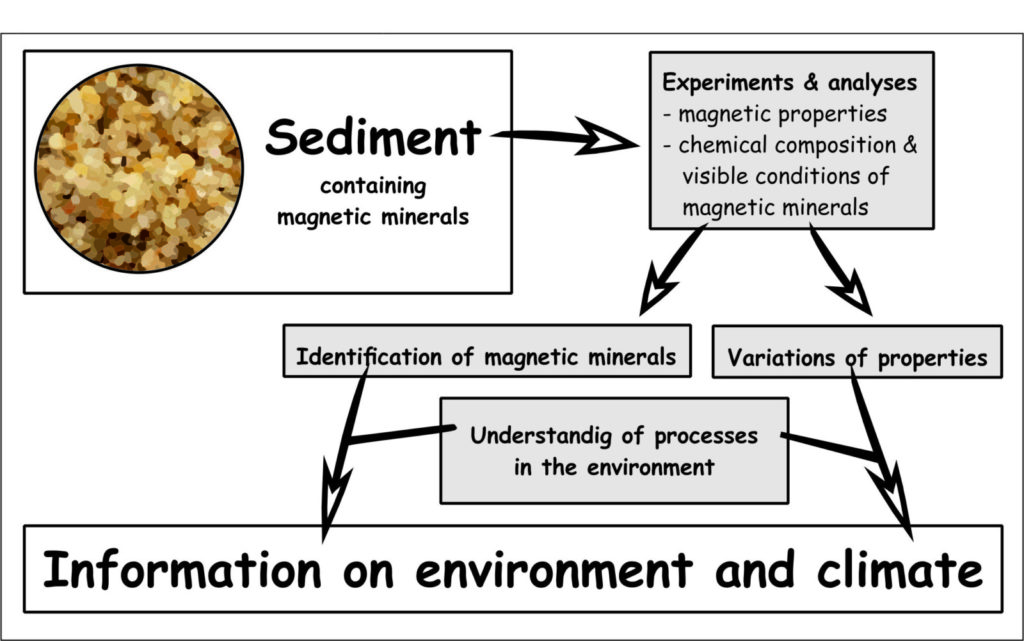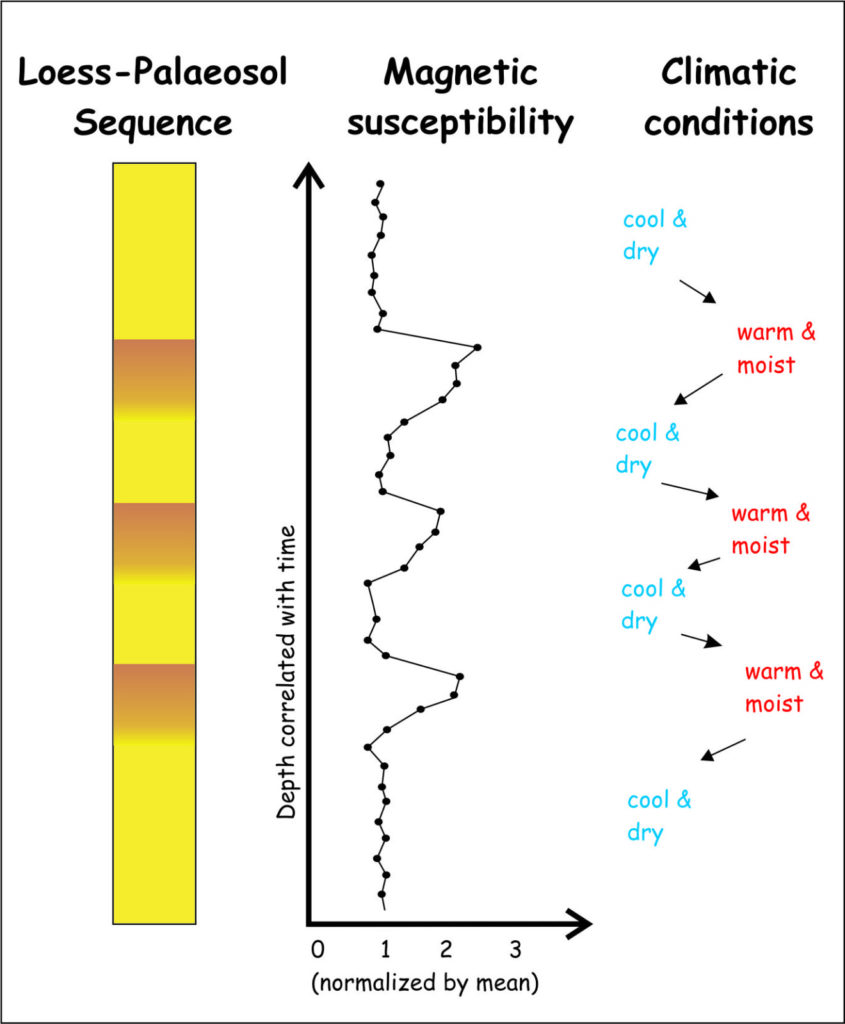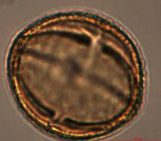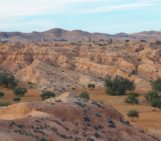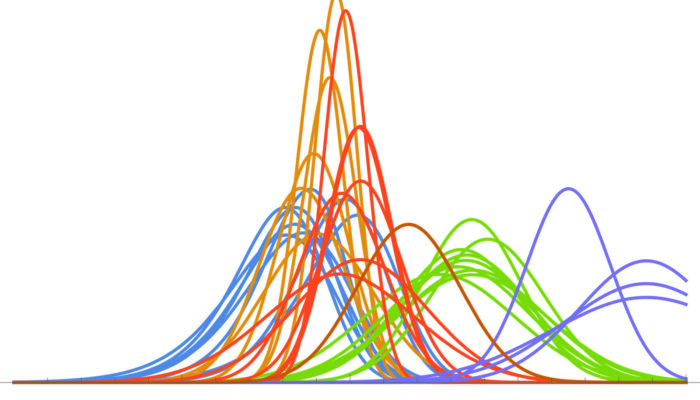
Name of proxy
Environmental Magnetism (also known as enviromagnetics)
Type of record
Environment and climate proxy
Paleoenvironment
Sedimentary environments (for the most part)
Period of time investigated
Present times to millions of years (depending on the preservation conditions)
How does it work?
Magnetism is a physical property that results from the behaviour of elementary particles in any substance. Depending on the chemical composition and distribution of elements within the material, different kinds of magnetism may result. In environmental magnetism mainly the strong magnetic iron minerals in samples are analyses to gain information on environmental processes and climatic conditions. These samples frequently originate from hard or soft rocks from land, caves, lakes, rivers, or oceans. However, the method can be used to monitor environmental pollution in dust, water, or sediments as well [1].
Figure 1. Simplified representation of the methodological approach.
The presence or absence of certain minerals in a sample and its properties (e.g. their physical appearance) are typical of specific environmental and climatic conditions (Fig. 1). This is the basic assumption of environmental magnetism. The minerals can be detected by modern equipment even when they are only present in trace amounts. The identification of the minerals is performed by a number of experimental procedures, which all focus on monitoring changes in magnetic properties while subjecting the sample material to different magnetic fields or temperatures. The resulting measurement signal always shows the behaviour of all magnetic components in the sample material. This signal can already be used as proxy for environmental changes and climate conditions. However, only successively performed data analyses allow to distinguish different kinds of magnetic particles by varying magnetic properties. To fully understand the palaeoclimatic and palaeoenvironmental information of the collected data, one needs the information on the components and must understand the processes that form, transform, or break down magnetic minerals. If magnetic minerals are extracted from sample material, they can be subjected to optical or chemical analysis. Thereby, information on the physical appearance of individual grains and their exact chemical composition can supplement the magnetic data.
What are the key findings that have been done using this proxy?
Magnetic analyses were used to unveil environmental conditions in numerous studies. A famous example is the analysis of air-blown sediments (loess) from China [2]. The study of a thick sequence of more than a 100 m shows an alternation of high and low magnetisation values, which correspond to colour changes from brownish to yellowish, respectively (Fig. 2). The brownish sediments were formed during moist and warm conditions, whereas the yellowish loess deposits were accumulated during cold and dry periods. The variation in magnetic properties results from the different processes associated to the formation of minerals in soils, which only take place in warm and moist climates. The occurrence of these newly formed minerals can be monitored by the magnetic susceptibility, which is a measure of a material’s ability to be magnetized. Thereby, the magnetic susceptibility of the Chinese loess is a palaeoclimatic proxy for variations in temperature and rainfall. This information was used for the reconstructions of the past atmospheric circulation pattern and the evolution of the Asian monsoon.
Figure 2: Illustration of the change of a bulk sediment property, using the example of susceptibility. No real data is shown.
In another example, environmental magnetism was applied to sediment cores from the Heidelberg Basin in Germany [3]. Because of the complex genesis of these fluvial deposits, the sediments are composed of a number of different magnetic minerals, which are all telling parts of the story of this region. To identify the different minerals, their individual magnetic signals were extracted from the overall magnetic signal by different very specific and time consuming analytical methods. Additionally, the physical conditions of the magnetic minerals were determined (e.g. grain shape). The combination of all results revealed the lower half of the investigated sediment cores to be deposited under Mediterranean climate conditions in which the groundwater table fluctuated, while the upper part was formed under cooler climates and stable groundwater conditions. Geological archives of the evolution of the Rhine River are rare and most methods fail to disclose details on the past climate conditions. Here, environmental magnetism provides valuable information on the hydrological regime and the climatic conditions.
Taken together, environmental magnetism is a non-destructive method that is applicable in a number of geological settings. The strengths of the method are manifold. In some settings well constraint information can be gained by fast and non-destructive measurements (example one). In other geological settings information on climatic and environmental conditions is unveiled, when other methods fail to contribute any result (example two).
This post has been reviewed by the editorial board
References [1] EVANS, M. E. & HELLER, F. (2003) Environmental Magnetism - Principles and Applications of Enviromagnetics, San Diego, Academic Press. [2] HELLER, F. & TUNG‐SHENG, L. (1986) Palaeoclimatic and sedimentary history from magnetic susceptibility of loess in China. Geophysical Research Letters, 13, 1169-1172. [3] SCHEIDT, S., EGLI, R., FREDERICHS, T., HAMBACH, U. & ROLF, C. (2017) A mineral magnetic characterization of the Plio-Pleistocene fluvial infill of the Heidelberg Basin (Germany). Geophysical Journal International, 210, 743-764.

